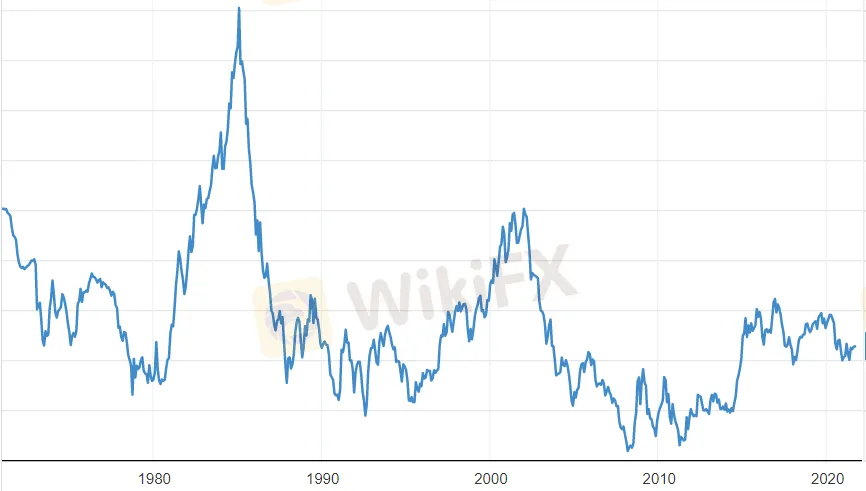What's the US Dollar Index and how can you trade it?
Zusammenfassung:The US Dollar Index (DXY) measures the value of the dollar against a basket of six major currencies, based on the exchange rates of these currencies. The index was created as an indicator of the weakness or strength of the U.S. dollar relative to other currencies. It is considered as a guiding tool to buy or sell currencies, especially the US dollar pairs, in the forex market.
The US dollar index commonly abbreviated DXY, measures the value of the United States Dollar relative to six major currencieswhich are the Euro, Japanese Yen, Canadian Dollar, British Pound, Swiss Franc, and the Swedish Krona.
The Euro is the most significant currency in the dollar index accounting for 57.6% of the basket. The Japanese yen (JPY) contributes by 13.6%, followed by the British Pound (GBP) by 11.9%, the Canadian Dollar (CAD) by 9.1%, Swedish Krona (SEK) by 4.2%, and finally the Swiss Franc (CHF) by 3.6%.
The currency basket has been modified once since the creation of the index. In 1999, the euro replaced many European currencies previously in the index, such as the Deutsche Mark, the previous currency of Germany. Other changes may be applied to the index in the coming years as currencies of major trading partners of the United States are expected to replace some of the existing currencies. The Chinese Yuan and Mexican Peso are highly nominated to be included in the index.
History of the Dollar Index
The dollar index was first created by the Federal Reserve in 1973 to track the value of the dollar after the collapse of the Bretton Woods Agreement and the abandoning of the gold standard. That allowed the value of the dollar to float freely after being fixed at $35 per ounce of gold under the Bretton Woods Agreement.
Since then, the Index has provided a method for markets to establish the globes reserve currency value.
The dollar index all-time high was recorded at 163.83 on March 5, 1985. While the all-time low was 71.58 on April 22, 2008. The index was launched at 100, the base value of the dollar.

The Intercontinental Exchange (ICE) has managed and owned the index since 1985.
Why is the Dollar Index important for FX Traders?
FX traders are watching the Dollar Index gauge and monitor the value of the Greenback against major currencies. If a trader is convinced the Dollar will appreciate relative to its counterparts, it might be simpler to place a single trade betting on a rising US Dollar Index instead of opening multiple forex positions. It also can be used to detect the direction of the USD currency pairs.
How to trade the Dollar Index?
The US Dollar Index can be traded just like an equity index. Rather than trading several USD pairs, you can simply trade one index according to the overall market sentiment, economic conditions, and policy stances. The index has gained its popularity among FX traders as a gauge of the value of the dollar against other currencies, helping traders to analyze more currency pairs using only one tool. Due to the high volumes of trading, the spreads or commissions for the DXY can be competitive.
You can adjust your trading positions based on whether the index is up or down. For example, if the index is bullish, you can buy USD/JPY and USD/CHF pairs or sell the EUR/USD and GBP/USD pairs.
Both technical analysis and fundamental analysis can be easily applied to the DXY while trading. However, you should pay attention to major factors like interest rates, monetary policy decisions, and market risk mode.
Now that you have an overview of the USD Dollar Index, make your knowledge profitable. Open forex account and enjoy reliable trading conditions and flexible forex leverage with the access to forex, indices, metals, and cryptocurrencies. AximTrades MT4 provides extensive tools for price analysis with a set of in-built technical indicators and charting tools.
WikiFX-Broker
Aktuelle Nachrichten
Ähnlich zum bedingungslosen Grundeinkommen? Donald Trump plant einen Staatsfonds
Verhandlungen bei japanischen Autobauern: Nissan zieht sich offenbar aus Fusionsgesprächen mit Honda zurück
Mindestlohn sorgt für weniger Lohngefälle und kleineren Niedriglohnsektor – doch die Bewährungsprobe steht jetzt erst bevor
Nach Unstimmigkeiten bei Strategie von Milliarden-Konzern: Wago entlässt mit sofortiger Wirkung seinen CEO
Er zeigt, wie deutsche Deeptech-Startups erfolgreich sein können
Neue VW-interne Überlegung: Wo der künftige 20.000-Euro-Stromer gebaut werden soll
Deutscher Multi-Millionär will mit Schach das große Geschäft machen – und legt sich mit dem Weltverband an
Experten: Paket-Stopp aus China bedeutet nicht das Ende von Shein und Temu in den USA
Überraschende Preissenkung bei Kaufland und Lidl: Butter jetzt günstiger
Bonk Preis-Prognose: Es werden 2,02 Billionen BONK-Münzen verbrannt
Wechselkursberechnung


